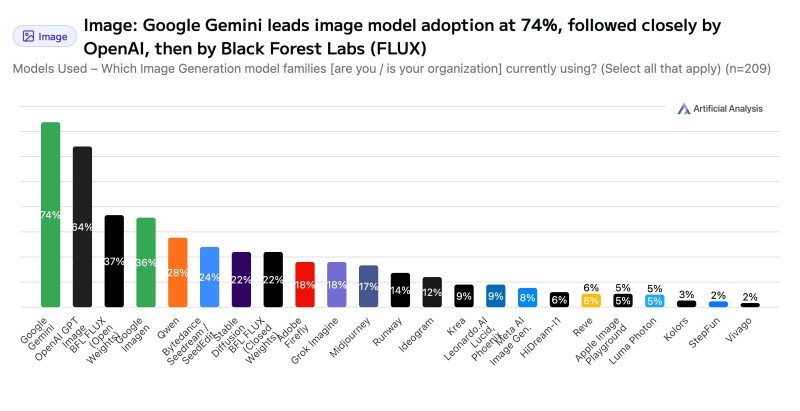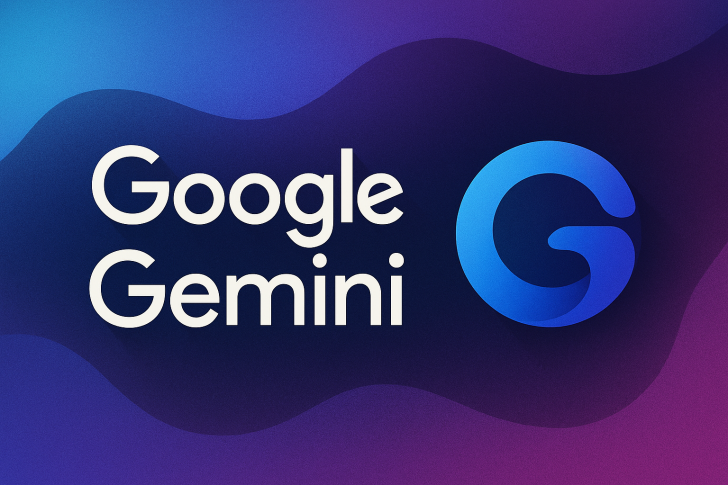The competition for AI image model dominance is heating up in 2025, and the latest data shows a clear frontrunner. Google Gemini has captured 74% of the market, with OpenAI trailing at 64% and Black Forest Labs' FLUX models securing third place at 37%. These findings come from the State of Generative Media Survey Report 2025, which surveyed roughly 300 developers and creators, offering a detailed look at how the AI community is embracing generative media for both images and videos.
Google and OpenAI Dominate the Market
The numbers from Artificial Analysis tell a compelling story about who's winning the generative image race. Google Gemini's 74% adoption rate isn't just impressive—it reflects how deeply the model has embedded itself into creative workflows, educational platforms, and enterprise systems. It's become the default choice for professionals and hobbyists alike.

OpenAI's 64% share highlights a different kind of strength: accessibility. Image creation through ChatGPT has made generative visuals incredibly approachable, blending conversational ease with quality results. It's brought AI art to people who might never have touched a traditional design tool.
Meanwhile, Black Forest Labs has carved out a solid position at 37% with their FLUX models. Developers who value open, customizable solutions are flocking to both the open-weight and closed-weight versions (22% combined), signaling a real appetite for flexible, self-hosted AI systems that put control back in users' hands.
A Diverse Ecosystem Beyond the Big Three
The market isn't just a two-horse race with a distant third. There's a thriving ecosystem of specialized tools serving different niches and preferences:
- Google Imagen — 36%
- ByteDance's SeedeDream and SeedeEdit — 28%
- Diffusible FLUX — 24%
- Adobe Firefly and Grok Imagine — 18% each
- Midjourney — 17%
- Runway — 14%
- Ideogram — 12%
- Krea, Leonardo.Ai, and Lucid Phoenix — 9% each
- Reve, Apple Image Playground, and Luma Photon — 5–6% each
This spread shows that while Google and OpenAI command the largest audiences, there's plenty of room for players who target specific creative communities or offer unique features. Adobe Firefly's 18% adoption makes sense given its integration with Creative Cloud, while Midjourney's 17% reflects its loyal community of visual artists. The emerging platforms at 5-6% adoption suggest the market is still evolving, with new entrants finding their footing.
What the Numbers Say About Usage Patterns
The broader report reveals interesting patterns beyond just image generation. Video creation tools are gaining ground too, with Google Veo leading at 69%, followed by Kling, Hailuo, Runway, and Alibaba's offerings. However, video adoption remains lower overall compared to images.
Right now, individual creators are driving most of the adoption, while organizations are still in testing phases. But image generation has already moved past experimentation into real production across entertainment, education, marketing, and brand content. These aren't just fun experiments anymore—they're integrated into actual workflows and business operations.
Integration Wins Over Raw Performance
What's becoming clear from these results is that the competition has shifted. It's no longer just about which model produces the best images. Integration and ease of use are becoming the real differentiators. Google's strength lies in weaving Gemini throughout its ecosystem—Workspace, Android, Search—so users encounter it naturally as part of their daily routine. OpenAI takes a different approach, making everything accessible through ChatGPT's simple conversational interface where text, images, and eventually video all live together.
Independent players like Black Forest Labs are succeeding by offering something the giants can't: true ownership and control. Their open-weight models appeal to developers and enterprises who want transparency, customization, and the ability to host their own solutions. As privacy and data control become bigger concerns, this positioning could pay off significantly.
 Victoria Bazir
Victoria Bazir

 Victoria Bazir
Victoria Bazir


